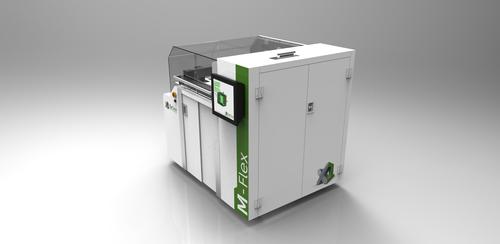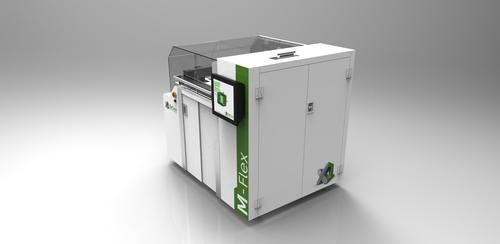October 17, 2012

Industrial 3D printing supplier ExOne, chosen to be a member in the US government-sponsored National Additive Manufacturing Innovation Institute (NAMII), has introduced a new printer the company claims boosts build volumes and speeds of metal parts.
The printer, dubbed M-FLEX, has a 400mm x 250mm x 250mm (15.7-inch x 9.8-inch x 9.8-inch) build chamber. This is more than seven times the volume of the company's previous midsized machine, the R2, Larry Voss, ExOne engineering manager, told us. It also achieves speeds of up to 30 seconds per layer, versus previous build speeds of about 90 seconds per layer on the R2. The printer is designed for manufacturing either prototypes or short runs of multiple and/or custom metal parts, for applications in the mining, automotive, and energy industries.

ExOne's existing printers include two of the largest available for making 3D printed parts in sand and metal. The S-Max, for printing sand casting molds and cores, has a build volume of 1,800mm x 1,000mm x 700mm (70-inch x 39-inch x 27-inch). The M-Print, for making near-net metal parts, has a build volume of 780mm x 400mm x 400mm (30.7-inch x 15.75-inch x 15.75-inch). The company also sells smaller M-Lab printers for glass and metal parts, with a build volume of 40mm x 60mm x 35mm (1.5-inch x 2.3-inch x 1.3-inch).
The M-FLEX employs ExOne's approach of utilizing a print head that distributes the binder into beds of specially formulated materials. The company recently displayed some of the largest sand molds and cores ever created with additive manufacturing at the 2012 International Manufacturing Technology Show.
Currently available materials include foundry-grade sand for the S-series printers, which employ the same binders used for doing normal sand-casting, said Voss. M-series printers use tool steel, bronze, and 420 and 316 stainless steel/bronze alloys, as well as recycled and opaque glass. "We plan to eventually add more material sets for the M-FLEX," said Voss. "These will include tungsten, glass, and ceramics, and some materials that are used in the casting industry."
Related posts:
About the Author(s)
You May Also Like



